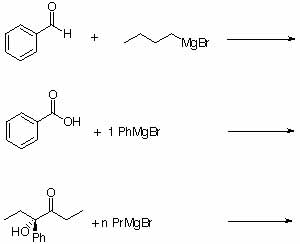
Week 8 Problem Set 30BL
ATTN: answers to the below questions are due at the start of your lab period; these answers should be part of your pre-lab write-up
1. Explain briefly why does your glassware have to be dry in this experiment.
2. Many Grignard reactions employ the use of bromides as a starting materials. Explain briefly.
3. In theory, tetrahydrofuran is a better solvent for Grignard reactions that diethyl ether. However, you will use diethyl ether. Explain briefly.
4. Why is 10% sulfuric acid added after the reaction is cooled?
5. Predict the products for the following reactions. Include the approximate ratio if more than one product obtained and the correct stereochemistry.

6. How many signals do you expect to observe in the 13C{1H}-NMR spectra of the following compounds? In which of the following ranges do those signals show up: 0-50 ppm, 50-100 ppm, 100-160 ppm, 160-220 ppm

Note:
There will be another spectroscopy seminar on Monday, February 24, 2003 at 6 pm in YH2200. The handouts are available in the instructor's office starting on Monday.
Topics: 13C and 1H-NMR spectroscopy (part I)